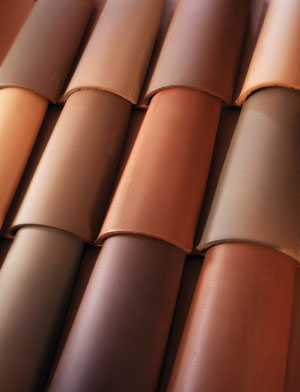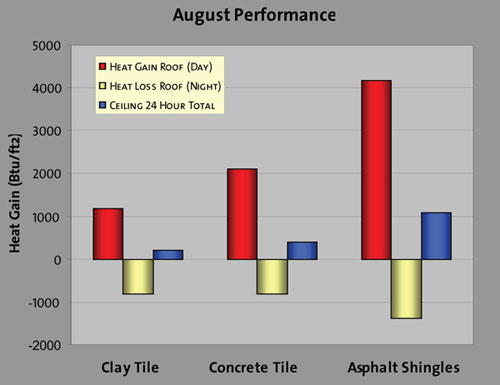Roofing Strategies Reach New Heights: Sustainable Options for a Key Building Element
Clay Tiles for Steep Slopes
Clay is one of the oldest roofing materials in existence, with clay tiles dating back as far as 3,000 B.C. in ancient civilizations in China and the Middle East. Clay's staying power stems from the fact that it is fire resistant, non-combustible, low maintenance, will not rot, and can stand up to strong winds, temperature changes, and freezing and thawing. Clay tiles made of naturally occurring materials will not fade over time. "They're 99 percent dirt and water," says US. Tile's Thomas, noting that natural clay tiles are 100 percent recyclable, and can contain as much as 59 percent recycled materials. Because it contains complex inorganic color pigments that boost its reflectance in the infrared spectrum, clay is said to have a natural reflectivity.
 |
In this "cool roof" blend, all clay tiles have an SRI value of greater than 29. Photo courtesy of US Tile |
The color in natural clay tiles is determined by the natural occurrence of trace elements such as iron, chrome and nickel, as well as by the kiln temperature, and oxygen present during the firing process. Alternatively, tiles can be coated during manufacturing, a somewhat easier and less expensive option than obtaining different clay sources to produce specific colors, the tradeoffs being authenticity and susceptibility to fading. Firing can be energy intensive, though natural clay tiles can utilize a quick fire method using a roller hearth kiln that cures the tiles in 60 to 110 minutes, lowering firing times and saving energy. Other manufacturers, particularly those that glaze tiles, use other types of kilns that can take up to one week to fire products. Over the past decade, the industry has been able to reduce energy usage significantly - some manufacturers claiming up to 27 percent - by continually upgrading equipment and process and utilizing alternative energy sources, such as solar energy or purchasing certificates for renewable energy off the grid.
Clay roofs can be used in any climate, and have a wide range applications on residences, small and large businesses, and academic buildings. Properly maintained clay roofs - either natural or coated - have life expectancies of 100 years or more. "The main reason for most roofing products' degradation is water absorption," says Thomas. "Products with the best longevity are typically those with low water absorption rates." To gain that property, all clay tiles, like bricks, are vitrified, meaning they are kiln fired to 2000 degrees Fahrenheit to achieve the density that will lock out water absorption. Very fine particle size also helps eliminate voids in the body of clay tile that limit water absorption even further. Clay tiles so fired are appropriate for any climate condition including salt intrusion experienced in coastal areas, severe freeze thaw action, and snow loads of harsh climates.
Depending on their color, natural reflectivity and glaze, some of today's clay tiles are rated "cool" by the Cool Roof Rating Council. A cool rated roof differs from a non-rated roof in two aspects: it reflects the sun better and dissipates heat more effectively. To measure reflectivity, a machine is used to take readings on six different random areas of an installed tile, with reflectivity based on an average of the readings. Emissivity is measured by a specialized emissometer machine that measures the amount of heat that travels through the product. Clay can reflect 53 percent of the sun's energy - vs. 10 percent for asphalt shingles - and emits 86 percent of the heat, allowing the roof surface to stay relatively cool compared to the ambient temperature. That, in turn, minimizes the heat island effect and interior heat fluctuations at the top of the building next to the roof. Clay has been shown to deliver up to 36 percent less ceiling heat fluctuation than concrete tile, and 75 percent less than asphalt shingles, reducing dramatic swings in ceiling temperatures, which saves energy and reduces the strain on building cooling systems, especially during peak expensive rate periods.
 |
|
Source: Oakridge National Laboratory |
Â
A cool roof doesn'thave to be a white roof. Even darker colored clay tiles can have an innate reflectivity that eliminates the need for paints or additives to reach an SRI (Solar Reflectivity Index) rating of 29 or greater, the magic number for LEED compliance on steep slope roofs. "Because of this natural reflectivity, clay colors that meet the LEED cool roof requirements are typically going to have darker and richer colors than other products such as concrete or asphalt," says Thomas.
In specifying clay tiles, architects will want to examine the manufacturers' warranties to be sure that they cover fading for at least 20 years. Another point to look for is Cradle to Cradle certification granted by MBDC (McDonough Braungart Design Chemistry), a consultancy founded in 1995 by architect William McDonough and chemist Michael Braungart to reorient the design of products, processes and systems to provide financial, environmental and societal benefits. C2C provides manufacturers with a means to measure achievement in environmentally intelligent design and helps customers purchase and specify products that are pursuing a broader definition of quality. Within the terms of the C2C program, this means using environmentally safe and healthy materials design for material reutilization, such as recycling or composting energy efficiency and the use of renewable energy efficient use of water, and maximum water quality associated with production; and instituting strategies for social responsibility. If a candidate product achieves the necessary criteria, it is certified as a Silver, Gold or Platinum product and can be labeled as Cradle to Cradle. In April 2007, the U.S. Green Building Council established an innovation point for specification of products certified under the Cradle to CradleSM (C2C) Certification program. "C2C is another opportunity for clay tiles to earn LEED points," says Thomas. "Clay tile roofs have the potential to help in seven or eight LEED categories, whereas other roofing systems may be able to help in two to three."









